Identifying Lyme Disease Rash From Pictures
Medically reviewed by Brendan Camp, MD
Lyme disease is a bacterial infection typically caused by Borrelia burgdorferi. It is spread through the bite of an infected tick. A Lyme disease rash generally occurs within a week of the infection. Many think of it as a bullseye rash, but it can appear in multiple ways.
This article will show how a Lyme disease rash looks and discuss other rashes that can be mistaken for Lyme disease.
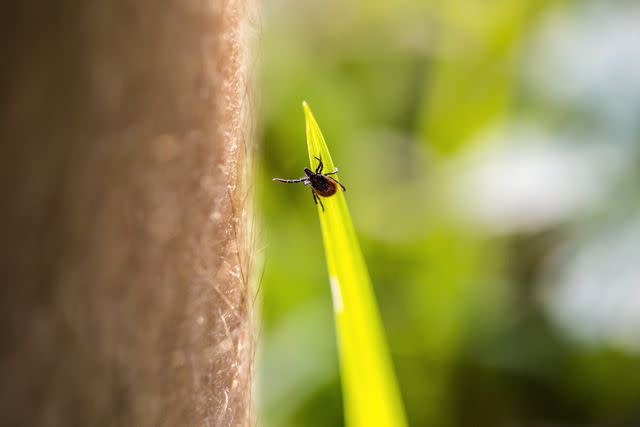
kmatija / Getty Images
How a Lyme Disease Rash Looks
Lyme disease can appear in a variety of ways. It can develop into a typical red rash that evolves into a bullseye or take on another variation. The information below will cover how Lyme disease rashes look.
Erythema Migrans: Early Stage Lyme Disease Rash
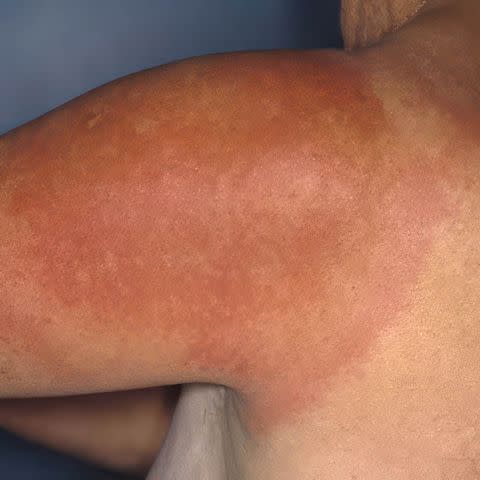
Reproduced with permission from © DermNet and © Raimo Suhonen dermnetnz.org 2023
During the early stage of Lyme disease, a rash called erythema migrans can develop. It will appear in 70% to 80% of people infected with Lyme disease. The rash will emerge three to 30 days after the tick bite, with an average appearance time of about seven days.
Erythema migrans can appear on any part of the body and will start at the site of the tick bite. It slowly expands over several days, growing to 12 inches or larger.
Erythema migrans rash can have a bump in the center where the tick bite occurred. The rash generally develops into a circle or oval shape. It can be warm when touched but is typically not itchy or painful.
As the rash expands, areas of redness can clear and develop into a bullseye rash.
It's important to note that an erythema migrans rash can vary in appearance and may not present as a classic textbook rash.
Bullseye Rash
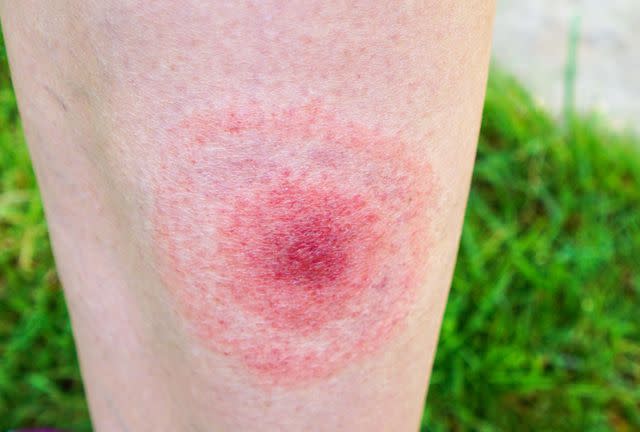
anakopa / Getty Images
An erythema migrans rash can develop into a bullseye rash. Some people may also describe the appearance of the rash as a target.
The middle of the rash will be a reddened circle shape, then a lighter circle will surround that, and finally, another reddened circle will surround the lighter circle.
A bullseye rash is rarely itchy or painful and may not always follow this description.
Other Lyme Disease Rashes
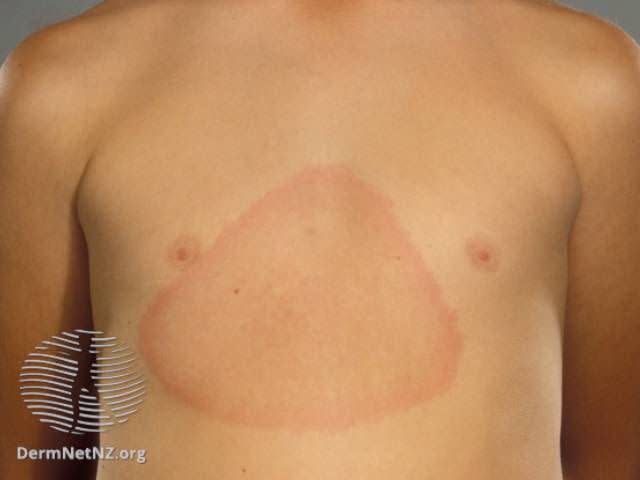
DermNet / CC BY-NC-ND
Lyme disease rashes do not always follow a specific pattern or appearance.
Some of the variations to the classic bullseye or erythema migrans rash include:
Faint or different coloring
Faint borders
Different shapes
Multiple rashes
Is Lyme Disease Contagious?
Lyme disease is a bacterial infection spread by the bite of an infected tick. It is not spread from person to person through kissing, touching, or sex. A pregnant person with untreated Lyme disease can spread the infection to the placenta. It is rare, but the infection can be spread from the pregnant person to the fetus.
Invisible Symptoms of Lyme Disease
Lyme disease produces more than just a rash. Approximately 50% of people will have flu-like symptoms that develop within a few days or weeks of the infection. These symptoms include:
Fatigue
Muscle aches
Headache
Swollen lymph node(s) around the site of the tick bite
Chills
Fever
Related: Common and Unusual Symptoms of Lyme Disease
Rashes Similar to Lyme Disease Bullseye
There are rashes caused by other health conditions or insects that can cause a rash similar to the Lyme disease rash. Below are rashes that are similar to Lyme disease rashes.
Ringworm
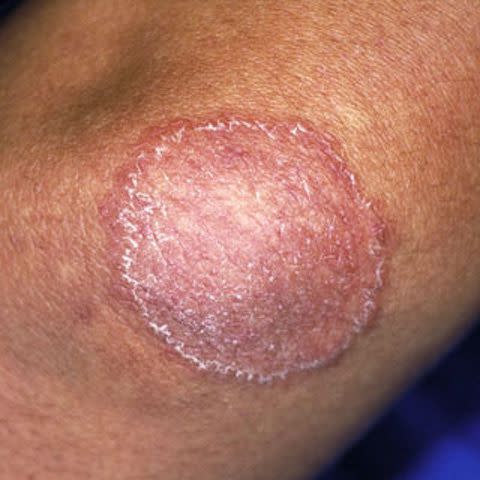
Reproduced with permission from ©DermNet NZ and ©Raimo Suhonen www.dermnetnz.org 2022
Ringworm is a fungal infection on the skin that causes a rash. The rash appears red and circular with scaly, bumpy edges. It feels itchy, burns, or can sting.
It can occur almost anywhere but is more commonly seen on the head, groin, and feet.
Hives
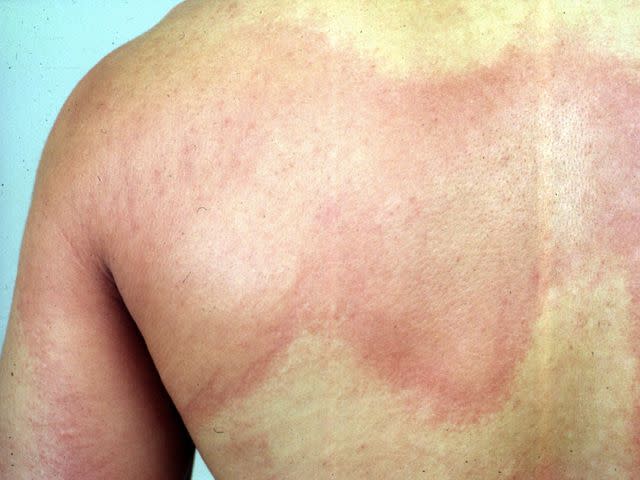
DermNet / CC BY-NC-ND
Hives, also known as urticaria, are raised red, itchy bumps. They blanch or turn white when pressed.
Hives can appear almost anywhere on the body. The shape and distribution of the rash can change.
There are numerous hive triggers, including:
Mood
Medications
Insect bites
Pollen
Infections
Cold weather
Other Bug Bites
A bug bite can develop a bump and redness resembling a Lyme disease rash.
Those hypersensitive to bug bites may develop a large red rash with a small bump near the center where the bug bite occurred. This can be difficult to differentiate from erythema migrans, except that it will not turn into a bullseye.
When to See a Healthcare Provider
Lyme disease is a serious infection that can spread to the heart, nervous system, and joints. It needs to be treated with an antibiotic.
Contact a healthcare provider if you have:
A tick bite or you live in an area known for Lyme disease
Been to an area where Lyme disease occurs
Also, contact a healthcare provider if a rash develops on the body and you believe it could be Lyme disease. Ticks carrying Lyme disease are extremely tiny and are easily missed, so someone may never have known that they were bit by the bug.
Summary
Lyme disease is a bacterial infection spread by ticks. In most people, it causes a red rash that can develop into a bullseye appearance. However, some people will not follow the classic bullseye rash and may have rashes of other colors or shapes.
Contact a healthcare provider anytime a tick bite from a Lyme disease-carrying tick is suspected.
Read the original article on Verywell Health.

